
Original Link: https://www.anandtech.com/show/2721
The Phenom II X4 810 & X3 720: AMD Gets DDR3 But Doesn't Need It
by Anand Lal Shimpi on February 9, 2009 12:00 AM EST- Posted in
- CPUs
We're in the midst of a price war folks, and at a time when the global economy is looking a little shaky this actually works very well for us. Let's recap what's happened.
AMD launched its first truly competitive CPUs in over two years in January: the Phenom II X4 940 and 920. Priced at $275 and $235 respectively, these two chips beat out the equivalently priced Intel CPUs, the Q9400 and the Q8200. If you haven't already, I would strongly suggest reading that article in order to get the background information necessary about what was changed in Phenom II to make it so competitive.
Less than two weeks later Intel responded by cutting its quad core prices. The table below shows what happened:
| Processor | Dec '08 Price | Jan '09 Price | % Decrease |
| Intel Core 2 Quad Q9650 (3.00GHz) | $530 | $316 | 40% |
| Intel Core 2 Quad Q9550 (2.83GHz) | $316 | $266 | 16% |
| Intel Core 2 Quad Q9400 (2.66GHz) | $266 | $213 | 20% |
| Intel Core 2 Quad Q8300 (2.50GHz) | $224 | $183 | 18% |
| Intel Core 2 Quad Q8200 (2.33GHz) | $193 | $163 | 16% |
AMD responded immediately, cutting its Phenom II prices to match:
| Processor | Launch Price | New Price | % Decrease |
| AMD Phenom II X4 940 (3.0GHz) | $275 | $225 | 18% |
| AMD Phenom II X4 920 (2.8GHz) | $235 | $195 | 17% |
We really have to applaud both companies here. Intel for responding so quickly and effectively; the 40% price drop on the Q9650 just made sense and now you can have a chip with 12MB of L2 cache for under $300 thanks to the Q9550. And we have to thank AMD for keeping the pressure on and making this possible.
The Phenom II X4 940 is once more priced similar to the Core 2 Quad Q9400, while the 920 is sort of in between a Q8300 and a Q9400. Based on last month's article we know that the Phenom II X4 940 is a better buy than the Core 2 Quad Q9400, but the 920 is a tougher sell compared to the Q8300/Q9400.
Phenom II: Now in Three Flavors
Things get more complicated with today's announcement; AMD is launching no less than five new Phenom II CPUs. Their specs and model numbers are below:
| Processor | Clock Speed | un-core Clock | L2 Cache | L3 Cache | TDP | Price |
| AMD Phenom II X4 940 | 3.0GHz | 1.8GHz | 2MB | 6MB | 125W | $225 |
| AMD Phenom II X4 920 | 2.8GHz | 1.8GHz | 2MB | 6MB | 125W | $195 |
| AMD Phenom II X4 910 | 2.6GHz | 2.0GHz | 2MB | 6MB | 95W | $??? |
| AMD Phenom II X4 810 | 2.6GHz | 2.0GHz | 2MB | 4MB | 95W | $175 |
| AMD Phenom II X4 805 | 2.5GHz | 2.0GHz | 2MB | 4MB | 95W | $??? |
| AMD Phenom II X3 720 BE | 2.8GHz | 2.0GHz | 1.5MB | 6MB | 95W | $145 |
| AMD Phenom II X3 710 | 2.6GHz | 2.0GHz | 1.5MB | 6MB | 95W | $??? |
| AMD Phenom 9950 | 2.6GHz | 2.0GHz | 2MB | 2MB | 140W | $173 |
The Phenom II X4 910 is just a lower clocked version of the CPUs we reviewed last month. The 800 series is a bit more unique, albeit not in a good way. The 900 series all have 2MB of L2 cache on die and a 6MB L3; the 800 shrinks the L3 down to 4MB. If you remember back to our original Phenom II article I argued that a big reason for the original Phenom's failure was that it didn't have a large-enough L3 cache. With a 6MB L3 the 900 series seemed like a good balance between L2 and L3 cache size, but going any smaller than 6MB could prove to be overly detrimental to performance. Also keep in mind that Intel's Ronak Singhal was adament that Nehalem shouldn't have any less than an 8MB L3 (or 2MB per core), even the mainstream Core i7 derivatives are slated to have 2MB of L3 cache per core (4MB for the dual-core versions).

A Phenom II X4 900 series die: 258mm2, 4-cores and a 6MB L3 cache
The 800 series is simply an example of die harvesting. Some of the die have too many defects in the L3 cache, but fully functional cores. Instead of throwing away these CPUs AMD turns them into the Phenom II X4 800 series. While physically the same die size and transistor count of the 900 series, these chips simply have some of the L3 cache disabled:
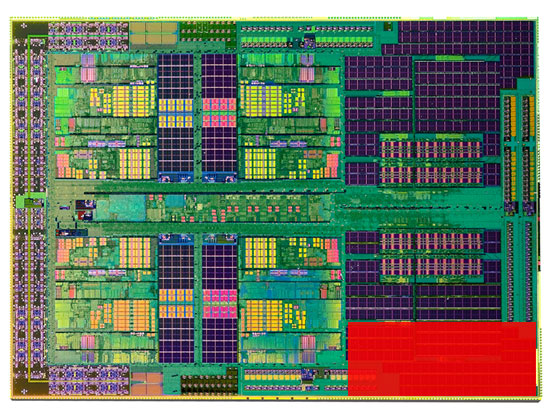
A Phenom II X4 800 series die: 258mm2, 4-cores and a 4MB L3 cache
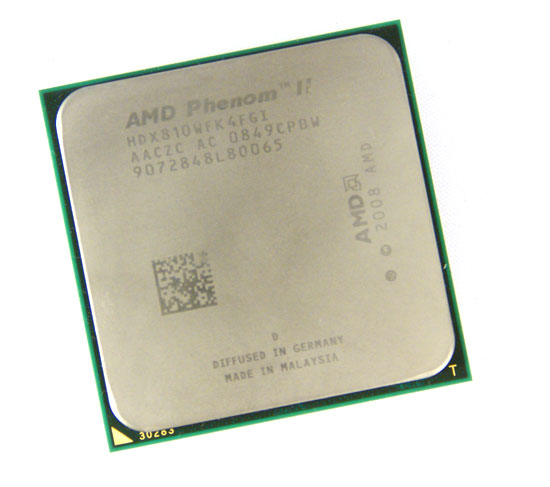
We've also got the Phenom II X3 720 and 710. These are both triple-core derivatives, once again they are physically the same die as the Phenom II X4 900 series, but this time with only 3 cores enabled. These are further harvested parts used simply to improve yields. I suspect that between the Phenom II 900, 800 and 700 series AMD is able to use as much of a single wafer as possible, all through harvesting and by targeting different price points. Note that this is a smart strategy to compete with Intel because Intel's 45nm yields are already quite mature, thanks to a year-long head start.
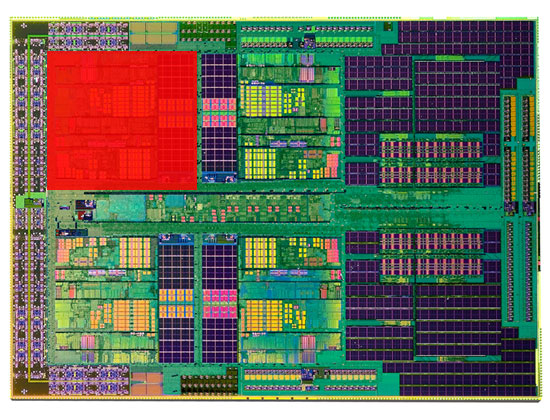
A Phenom II X3 700 series die: 258mm2, 3-cores and a 6MB L3 cache
As yields improve over time you can expect some of these parts to go away. But for now, AMD basically has a single Phenom II die that it's selling three different ways.
The 700 series is arguably one of the best harvested Phenom II parts AMD has since it retains the 6MB L3 cache of the 900 series. With 2MB of L3 cache per core, this bests even the 900 series.
When AMD produces a Phenom II die if part of the L3 is bad, it gets disabled and is sold as an 800 series chip. If one of the cores is bad, it gets disabled and is sold as a 700 series chip. If everything is in working order, then we've got a 900.
The Economic Problem
For the consumer, AMD's pricing strategy is incredible. For AMD and its shareholders however, the pricing is a bit tough. The Phenom II X4 940 is priced similarly to the Core 2 Quad Q9400, a chip that is 36% smaller than AMD's offering. The Phenom II X4 810 goes up against the Q8300, again, a chip that's 36% smaller. The Phenom II X3 720 is even worse shape; AMD is selling a chip that's 258 mm2 at the same price Intel sells a 82 mm2 chip; that's a 68% smaller die at the same price.
| AMD CPU | AMD Die Size | Competitive Intel CPU | Competitive Intel Die Size | Intel Size Advantage |
| AMD Phenom II X4 900 series | 258 mm2 | Intel Core 2 Quad Q9xxx/Q8xxx | 164 mm2 | 36% |
| AMD Phenom II X4 800 series | 258 mm2 | Intel Core 2 Quad Q8xxx | 164 mm2 | 36% |
| AMD Phenom II X3 700 series | 258 mm2 | Intel Core 2 Duo E7xxx series | 82 mm2 | 68% |
AMD in many cases delivers greater performance than the similarly priced Intel CPUs, but not nearly a large enough performance gap to make up for the difference in die size. Again, great for consumers, but potentially painful for AMD in the long run. As yields improve AMD should be able to make more of these cores members of the 900 family, but without a separate, smaller die there will still be economic inefficiencies at the lower end.
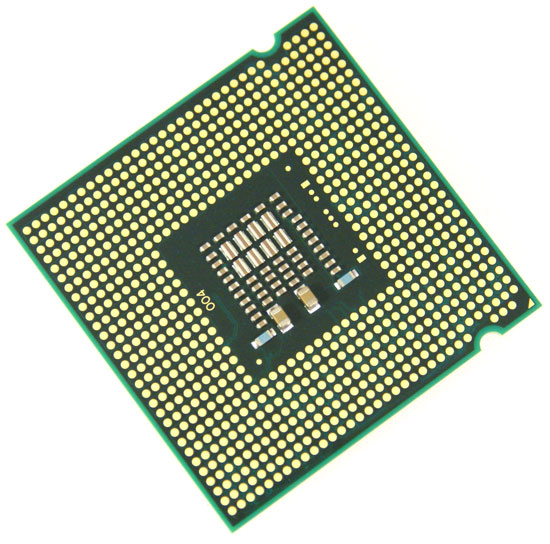
The Core 2 Duo E7500, Intel's high-margin competitor to the Phenom II X3 700 series
Lower TDPs, Faster un-core, DDR3 Support: The new Phenom II
All of the CPUs launching today are Socket-AM3 compatible. If you remember from my original Phenom II article, a Socket-AM3 CPU can work in both AM3 and AM2+ motherboards. I made a cute little compatibility matrix for you guys:
| CPU/Motherboard | Socket-AM2 MB | Socket-AM2+ MB | Socket-AM3 MB |
| Socket-AM2 CPU | Yes | Yes | No |
| Socket-AM2+ CPU | Maybe | Yes | No |
| Socket-AM3 CPU | Maybe | Yes | Yes |
AMD carefully engineered its AM3 memory controller allowing it to operate in both DDR2 and DDR3 modes. Any AM3 CPU can thus work in either a Socket-AM3 motherboard with DDR3 memory, or in a Socket-AM2+ motherboard with DDR2 memory. Backwards compatibility with original Socket-AM2 motherboards is up to the motherboard vendor, AMD does not validate any AM3 CPUs in regular AM2 motherboards.
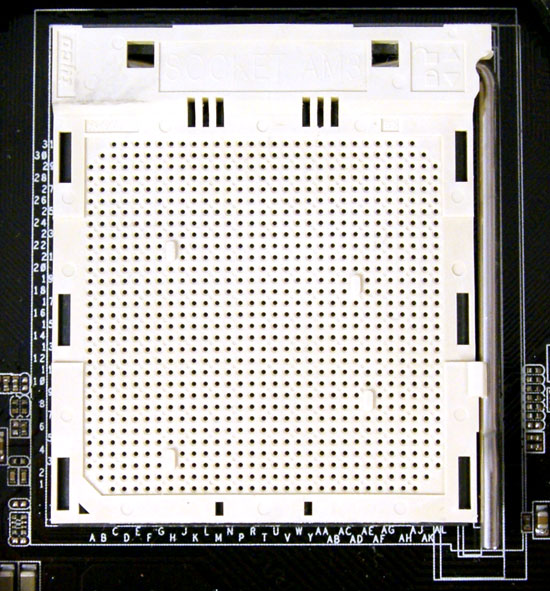
The new Socket-AM3. Socket-AM2/AM2+ CPUs won't fit in here. But AM3 CPUs will fit in AM2+ boards.
All of the Socket-AM3 Phenom II CPUs are 95W TDP parts, compared to 125W for the first two chips that launched in January. The other notable change is that all of the AM3 CPUs run their un-core (North Bridge + L3 cache) at 2.0GHz instead of 1.8GHz like the AM2+ Phenom II processors.
Socket-AM3 Motherboards: Don't Bother Yet
I've had a Socket-AM3 motherboard here for a while but honestly the performance just isn't worth it. While it's taken a while to get stability up to par with AM2+, overall system performance remains unaffected. The Socket-AM2+ to Socket-AM3 transition looks a lot like the Socket-939 to Socket-AM2 transition we saw back in 2006.
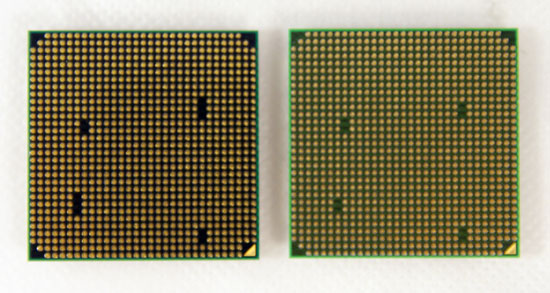
A Socket-AM3 CPU (left) vs. a Socket-AM2 CPU (right) Note the missing pins on the AM3 chip.
Thankfully AMD gives you the option to ugprade whenever you'd like. You can buy a Socket-AM3 CPU today and use it in either an AM2+ board or an AM3 board, provided there's proper BIOS support. DDR3 memory is still more expensive than DDR2 and offers no real world performance advantage even at DDR3-1333 speeds.
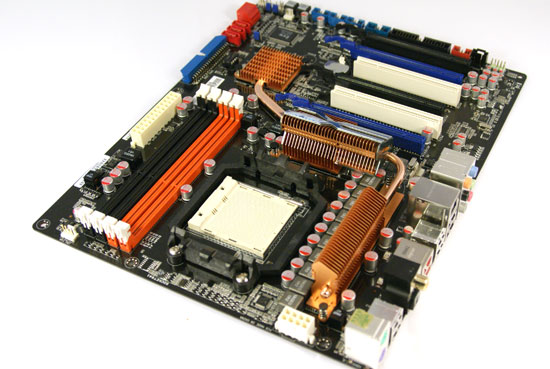
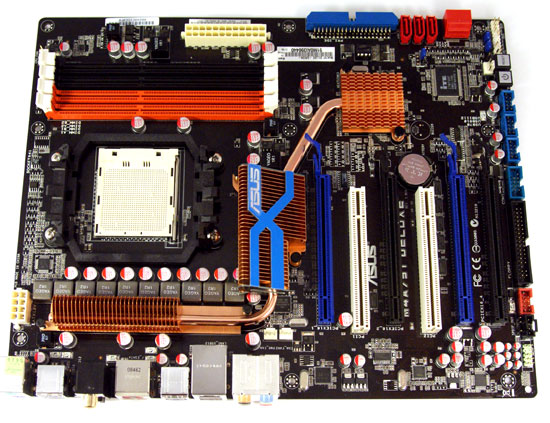
Note that Socket-AM3 CPUs will only officially support one DIMM per channel running at 1333MHz. You'll need to run at 1066MHz speeds if you're running four DIMMs. When DDR2 and DDR3 memory reach price parity at the end of this year, AMD will be in a good position to make the transition. But if you're buying today, find a good AM2+ board and some cheap DDR2 memory.
The Test
| Motherboard: | Intel DX58SO (Intel X58) Intel DX48BT2 (Intel X48) MSI DKA790GX Platinum (AMD 790GX) |
| Chipset: | Intel X48 Intel X58 AMD 790GX |
| Chipset Drivers: | Intel 9.1.1.1010 (Intel) AMD Catalyst 8.12 |
| Hard Disk: | Intel X25-M SSD (80GB) |
| Memory: | G.Skill DDR2-800 2 x 2GB (4-4-4-12) G.Skill DDR2-1066 2 x 2GB (5-5-5-15) Qimonda DDR3-1066 4 x 1GB (7-7-7-20) |
| Video Card: | eVGA GeForce GTX 280 |
| Video Drivers: | NVIDIA ForceWare 180.43 (Vista64) NVIDIA ForceWare 178.24 (Vista32) |
| Desktop Resolution: | 1920 x 1200 |
| OS: | Windows Vista Ultimate 32-bit (for SYSMark) Windows Vista Ultimate 64-bit |
SYSMark 2007 Performance
Our journey starts with SYSMark 2007, the only all-encompassing performance suite in our review today. The idea here is simple: one benchmark to indicate the overall performance of your machine.
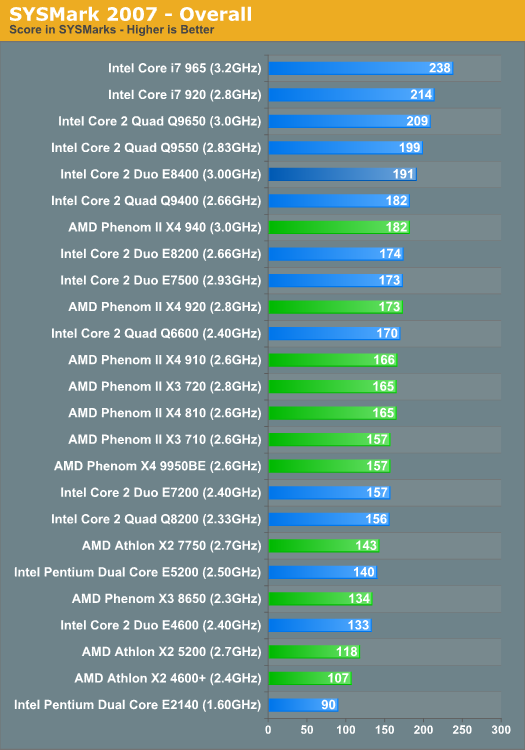
SYSMark is a great tool for showing off the fact that most applications are still not very well threaded and can't take advantage of more than two cores. Obviously if you're buying for the future then you'd want more cores, but today most users won't see a real benefit. The proof is in the pudding: look at the Phenom II X3 720 vs. the Phenom II X4 910 - the two offer identical performance. Sure the X4 910 has a larger L3 cache and the X3 720 has a faster clock speed, but the fourth core offers no real performance advantage.
Against to its Intel competition, the Phenom II X3 720 falls short of the Core 2 Duo E7500 and the E8400.
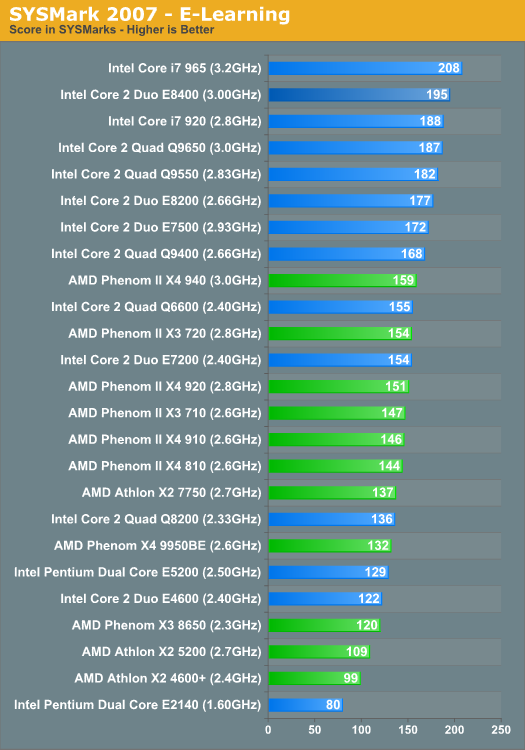
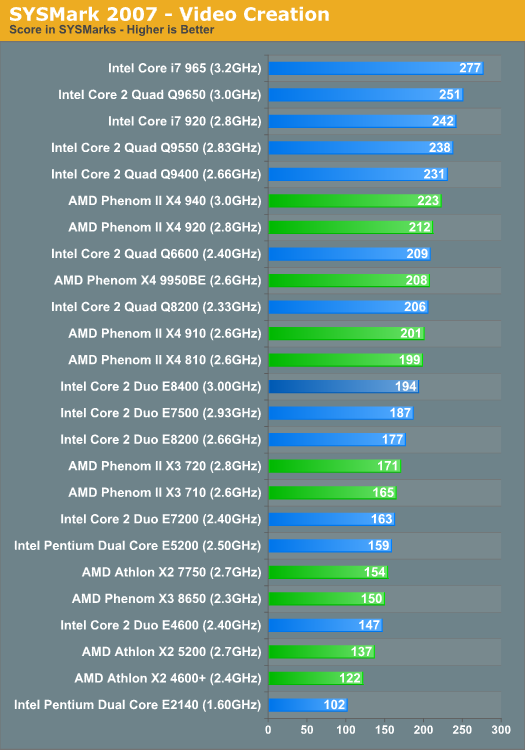
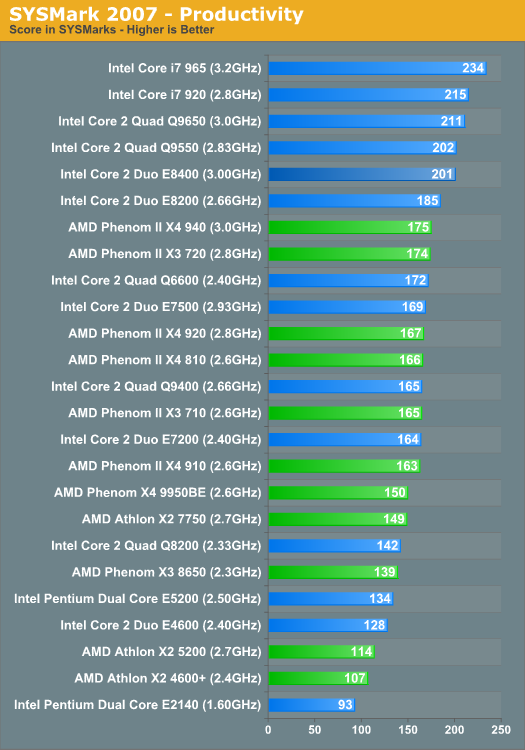
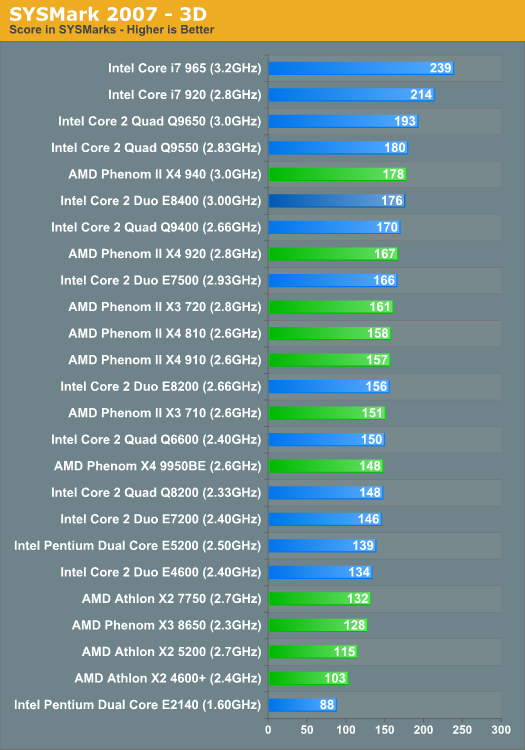
Adobe Photoshop CS4 Performance
To measure performance under Photoshop CS4 we turn to the Retouch Artists’ Speed Test. The test does basic photo editing; there are a couple of color space conversions, many layer creations, color curve adjustment, image and canvas size adjustment, unsharp mask, and finally a gaussian blur performed on the entire image.
The whole process is timed and thanks to the use of Intel's X25-M SSD as our test bed hard drive, performance is far more predictable than back when we used to test on mechanical disks.
Time is reported in seconds and the lower numbers mean better performance. The test is multithreaded and can hit all four cores in a quad-core machine.
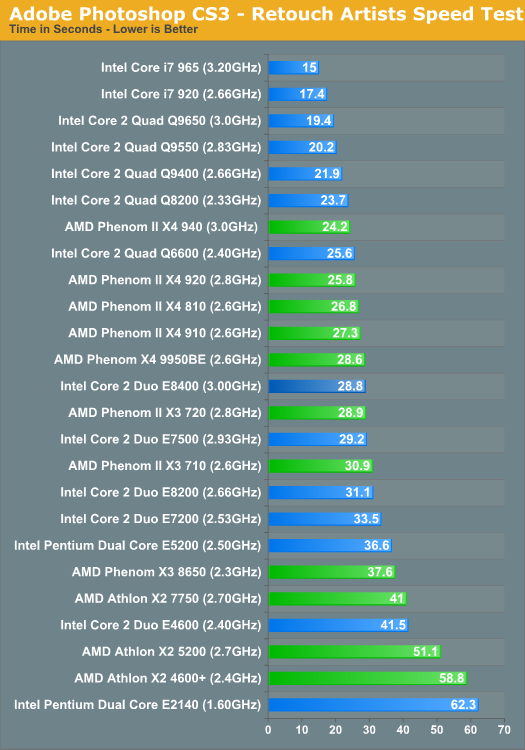
While our Photoshop CS4 benchmark clearly prefers Intel's CPUs, the results aren't so clean cut. The entire Phenom II 800 and 900 lineup falls short of their competitors, but the Phenom II X3 720 can equal its rival: the Core 2 Duo E7500. It's slower than the more expensive E8400, but it's at least competitive.
This is where AMD has some potential to do well. As a result of its larger die, the 720 has one more core than Intel's svelte Core 2 Duos. In well threaded applications, the X3 could come out ahead.
DivX 8.5.3 with Xmpeg 5.0.3
Our DivX test is the same DivX / XMpeg 5.03 test we've run for the past few years now, the 1080p source file is encoded using the unconstrained DivX profile, quality/performance is set balanced at 5 and enhanced multithreading is enabled:
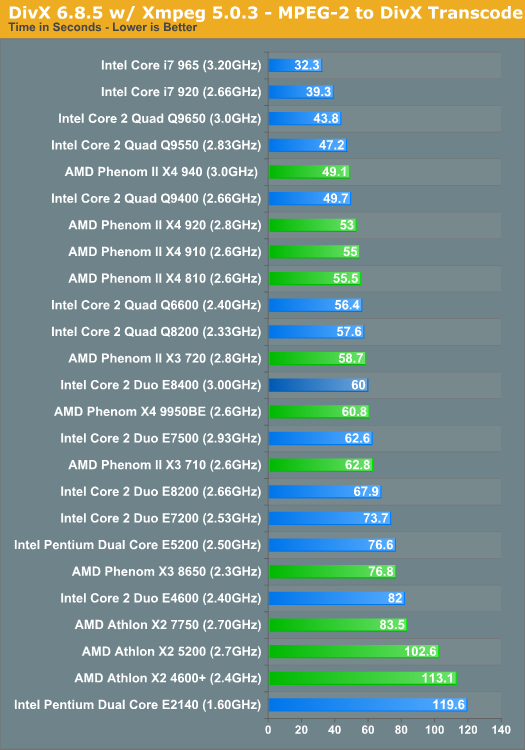
Both the Phenom II 900 and 800 series parts are competitive here. The Phenom II X3 720 actually beats out both competitors here, the E7500 and E8400 are close but no faster than the 720. Here's a benefit of that extra core at work.
x264 HD Video Encoding Performance
Graysky's x264 HD test uses the publicly available x264 codec (open source alternative to H.264) to encode a 4Mbps 720p MPEG-2 source. The focus here is on quality rather than speed, thus the benchmark uses a 2-pass encode and reports the average frame rate in each pass.
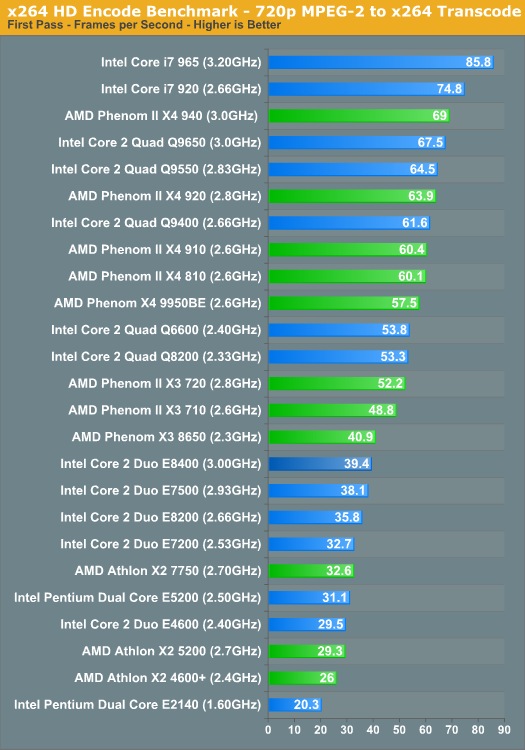
The first pass of the x264 benchmark is actually an analysis pass, the real encoding is done in the second pass. There are apparently quite a few unaligned cache accesses in this test which severely penalize the Core 2 processors; Core i7 is unaffected. Because of the unaligned cache access performance penalty, AMD owns the price/performance comparison here.
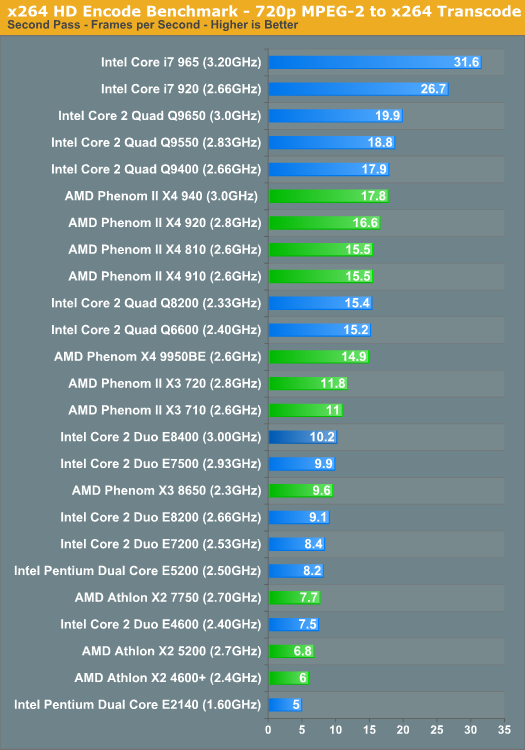
The actual encode workload is much more competitive. The Phenom II 800 and 900 series chips cluster around each other, remaining competitive but not really any faster than the equivalently priced Core 2 Quads. The Phenom II X3 720 continues to be faster than its competitor thanks to its core count advantage.
Windows Media Encoder 9 x64 Advanced Profile
In order to be codec agnostic we've got a Windows Media Encoder benchmark looking at the same sort of thing we've been doing in the DivX and x264 tests, but using WME instead.

Here we've got, once again, a competitive AMD but there's something very interesting going on with the triple core 720. WME9 doesn't make use of the third core as it is hard coded to use powers of 2 for the number of processor cores. There are some applications that will exhibit this sort of behavior, although in our testing the numbers are limited. With its third core out of the picture, the 720 is slower than Intel's Core 2 Duo E7500.
3dsmax 9 - SPECapc 3dsmax CPU Rendering Test
Today's desktop processors are more than fast enough to do professional level 3D rendering at home. To look at performance under 3dsmax we ran the SPECapc 3dsmax 8 benchmark (only the CPU rendering tests) under 3dsmax 9 SP1. The results reported are the rendering composite scores:
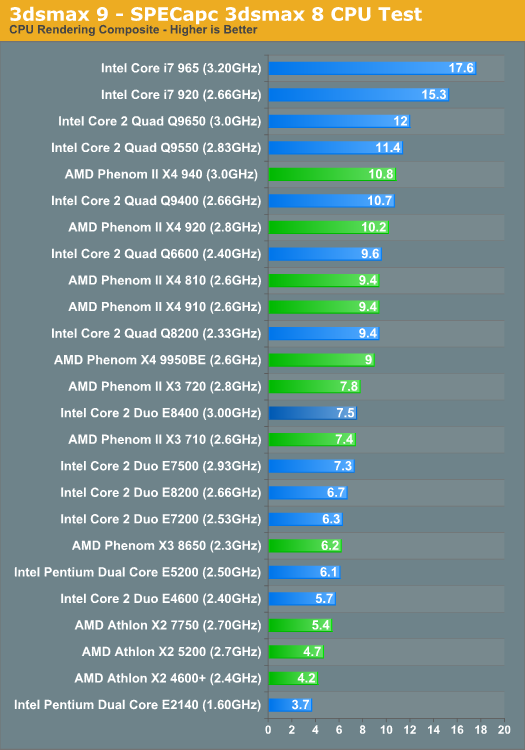
The Phenom II 900 and 800 series are once again competitive with the equivalent Intel offerings. Since we're dealing with a well threaded workload, the Phenom II X3 720 manages to inch ahead of its Core 2 Duo competitors.
Cinebench R10
Created by the Cinema 4D folks we have Cinebench, a popular 3D rendering benchmark that gives us both single and multi-threaded 3D rendering results.
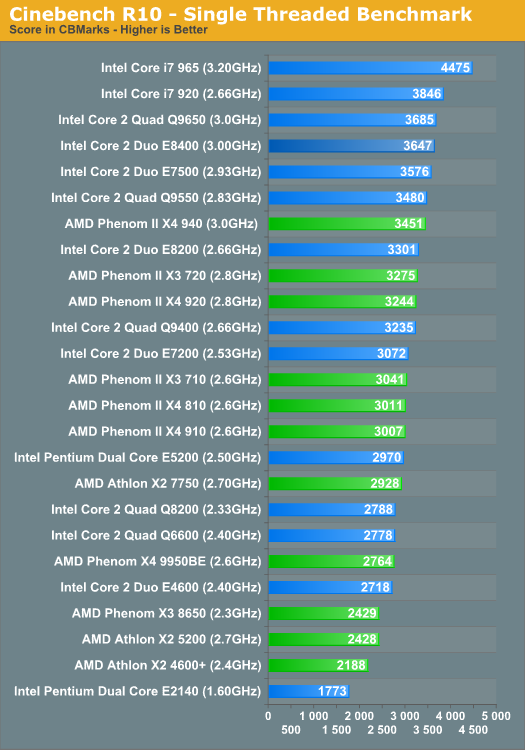
Taxing only a single core all you can rely on is frequency, hence the E7500 being at the top of the charts. But we are in the multi-core era, so let's look at the multi-threaded results:
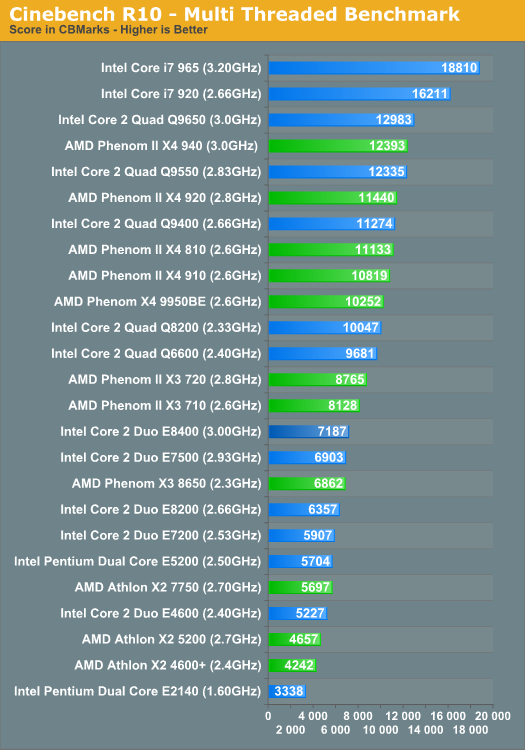
AMD does very well in the multi-threaded Cinebench test thanks to its architectu, only the fastest Core 2s and of course Core i7 are able to outperform the Phenom II. The triple core 720 has a clear advantage over its dual core competitors here.
POV-Ray 3.73 beta 23 Ray Tracing Performance
POV-Ray is a popular, open-source raytracing application that also doubles as a great tool to measure CPU floating point performance.
I ran the SMP benchmark in beta 23 of POV-Ray 3.73. The numbers reported are the final score in pixels per second.
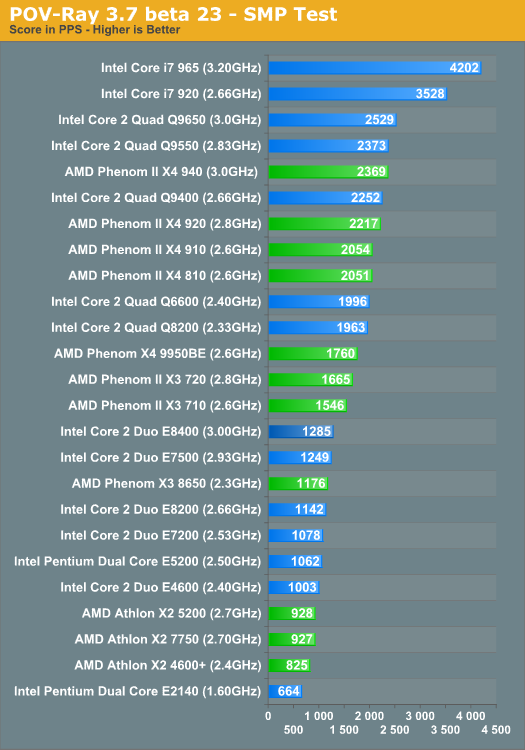
AMD continues to do quite well in POV-ray. The 900, 800 and 700 series are all competitive.
PAR2 Multithreaded Archive Recovery Performance
Par2 is an application used for reconstructing downloaded archives. It can generate parity data from a given archive and later use it to recover the archive
Chuchusoft took the source code of par2cmdline 0.4 and parallelized it using Intel’s Threading Building Blocks 2.1. The result is a version of par2cmdline that can spawn multiple threads to repair par2 archives. For this test we took a 708MB archive, corrupted nearly 60MB of it, and used the multithreaded par2cmdline to recover it. The scores reported are the repair and recover time in seconds.

The more cores the merrier; AMD does very well in our par2 test, especially down at the X3 720 level. Nothing can touch the 8-threads of madness that is Core i7 however, but today we're talking about much lower price points.
Blender 2.48a
Blender is an open source 3D modeling application. Our benchmark here simply times how long it takes to render a character that comes with the application.
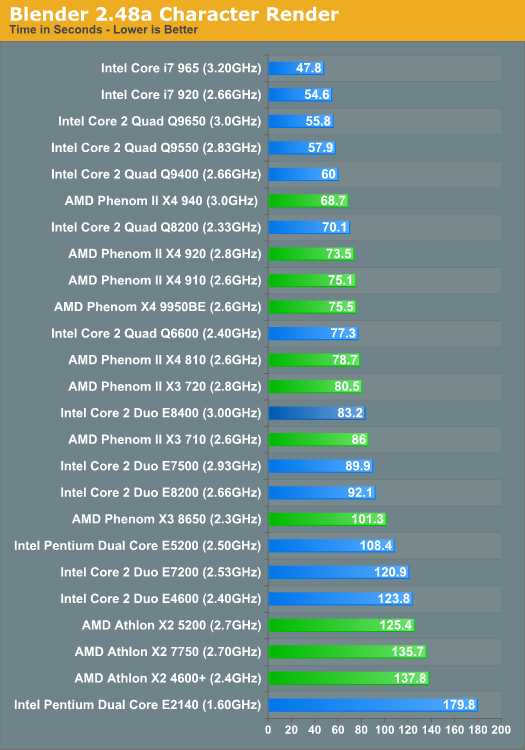
While AMD is competitive in many applications, some do favor Intel's architectures; Blender is one of them. Only the Phenom II 700 series is competitive thanks to its triple-core advantage.
Microsoft Excel 2007
Excel can be a very powerful mathematical tool. In this benchmark we're running a Monte Carlo simulation on a very large spreadsheet of stock pricing data.
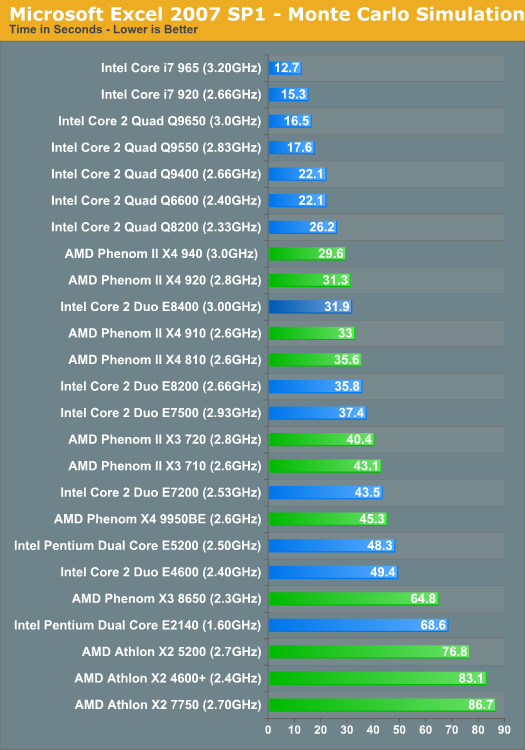
Sony Vegas Pro 8: Blu-ray Disc Creation
Although technically a test simulating the creation of a Blu-ray disc, the majority of the time in our Sony Vegas Pro benchmark is spend encoding the 25Mbps MPEG-2 video stream and not actually creating the Blu-ray disc itself.
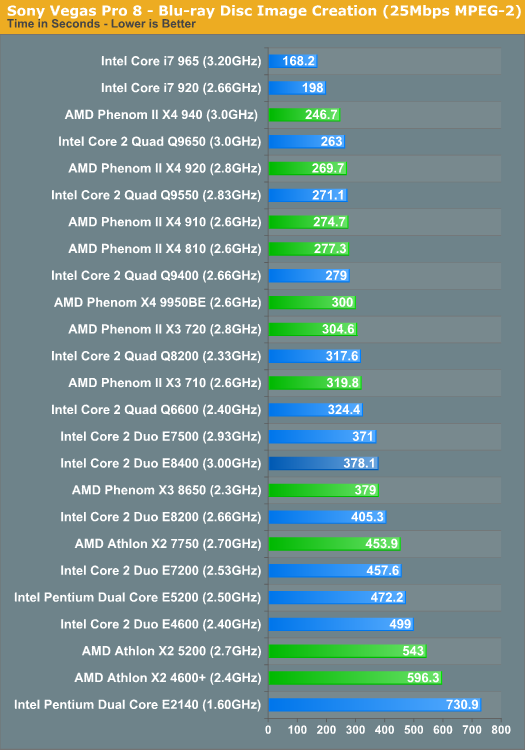
AMD is very competitive here, outperforming all of the equivalently priced Intel CPUs. The clock speed and cache advantage of the Phenom II X3 720 is enough to even outpace the Core 2 Quad Q8200.
Sorenson Squeeze: FLV Creation
Another video related benchmark, we're using Sorenson Squeeze to convert regular videos into Flash videos for use on websites.
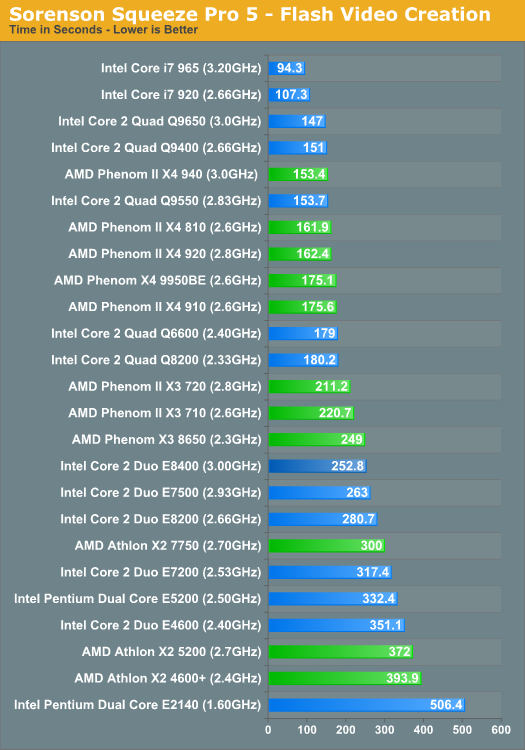
The performance breakdown is more of what we've been seeing here tonight.
WinRAR - Archive Creation
Our WinRAR test simply takes 300MB of files and compresses them into a single RAR archive using the application's default settings. We're not doing anything exotic here, just looking at the impact of CPU performance on creating an archive:

The entire Phenom II lineup ends up performing very similarly, largely because there are IO limitations at work here despite our use of an SSD. Cache size matters as Intel's smaller cache quad-core chips don't do nearly as well as the 12MB behemoths.
Fallout 3 Game Performance
Bethesda’s latest game uses an updated version of the Gamebryo engine (Oblivion). This benchmark takes place immediately outside Vault 101. The character walks away from the vault through the Springvale ruins. The benchmark is measured manually using FRAPS.
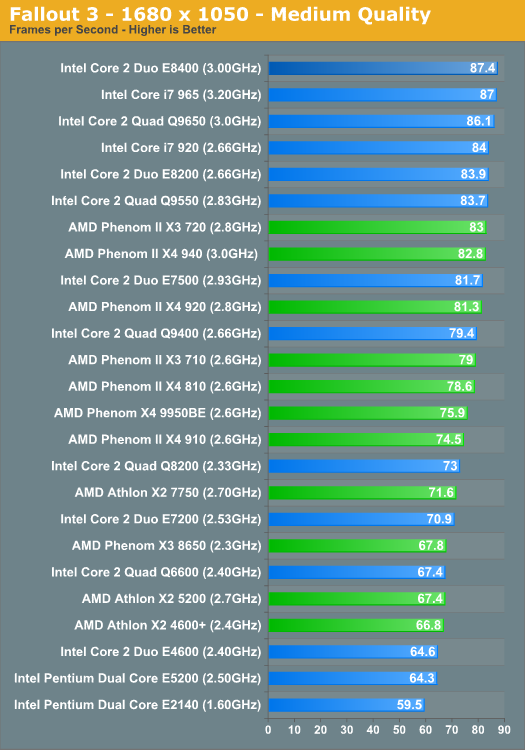
The Phenom II is finally a competitive gaming CPU, that's from top to bottom now.
Left 4 Dead
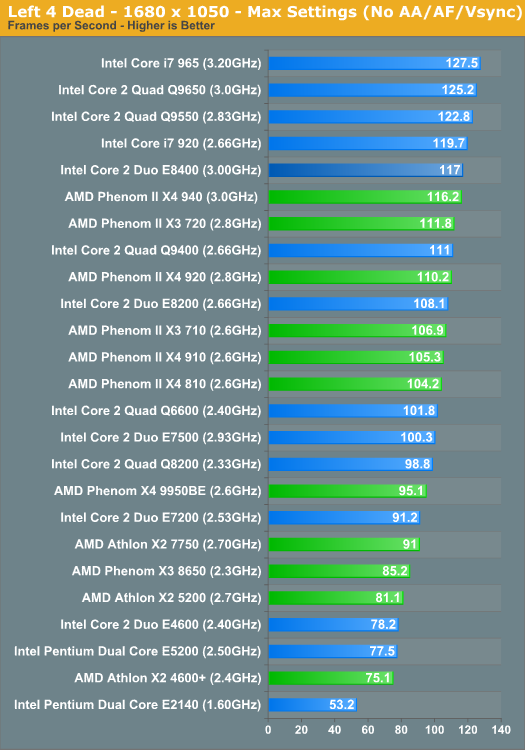
Left 4 Dead performance is also very competitive, AMD does quite well here.
FarCry 2 Multithreaded Game Performance
FarCry 2 ships with the most impressive benchmark tool we’ve ever seen in a PC game. Part of this is due to the fact that Ubisoft actually tapped a number of hardware sites (AnandTech included) from around the world to aid in the planning for the benchmark.
For our purposes we ran the CPU benchmark included in the latest patch:
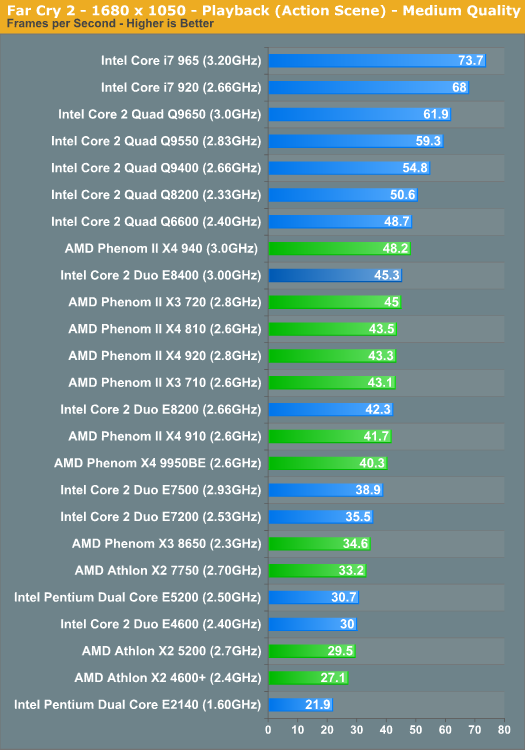
Both Far Cry 2 and Crysis Warhead favor Intel's CPUs and thus we don't see much competition from AMD here.
Crysis Warhead
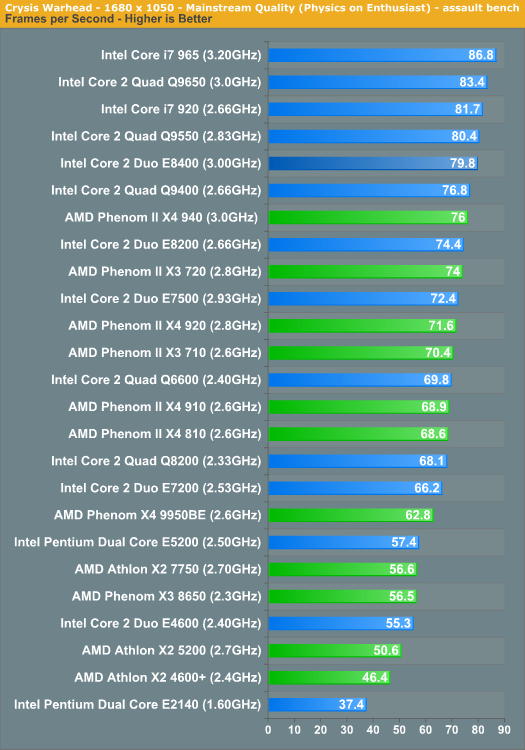
Power Consumption
Since we're looking at modern 45nm processors here, power consumption is pretty reasonable across the board.
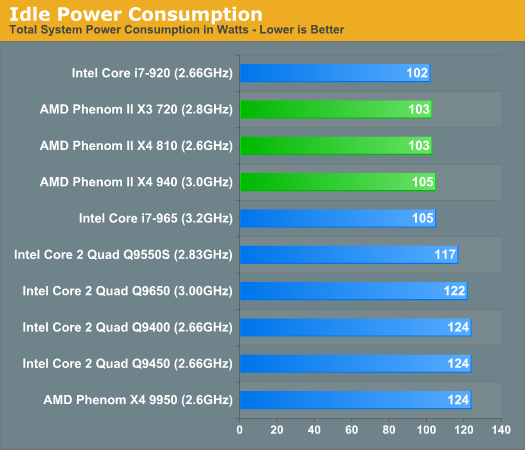
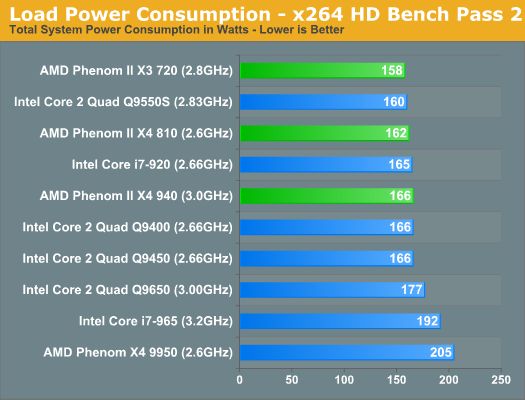
Overclocking-
Since all of the new AM3 parts are built off of the same Phenom II die as what we reviewed back in January, we'd expect similar overclocking results. While I worked on performance testing, Gary went to work on overclocking these new Socket-AM3 CPUs. What follows are his first experiences.
We are utilizing the ASUS M4A78T-E motherboard based on the AMD790FX/SB750 chipset for our overclocking tests, this is actually a Socket-AM3 motherboard. The Phenom II X4 810 and X3 720 BE processors are meant for the mid-range market and users are likely to pair them with the 790GX chipset or something similar. We will have additional overclocking results in the near future comparing various AM3 and AM2+ boards along with lower priced components. Our AM3 board selection currently includes the ASUS M4A79T Deluxe (790FX/SB750), ASUS M4A78T-E, and the ASRock M3A790GXH/128M, which upholds their ability to provide high HTT rates for locked processors on the 790GX chipset. We expect additional AM3 boards from MSI, Gigabyte, and others shortly.
We put an emphasis on stability during our testing sessions so we test with real world applications ranging from a variety of games to digital imaging software to various audio/video creation programs, along with the normal OCCT and PCMark Vantage tests. We focus on the type of overclocks that support 24/7 operation with reasonable cooling and the ability to run a multitude of programs without a problem. We are not optimizing for SuperPI or 3DMark records; it's more like trying to keep our bank records safe from a crash (sadly, there's nothing we can do about actual banks crashing).
Overclocking Test Setup
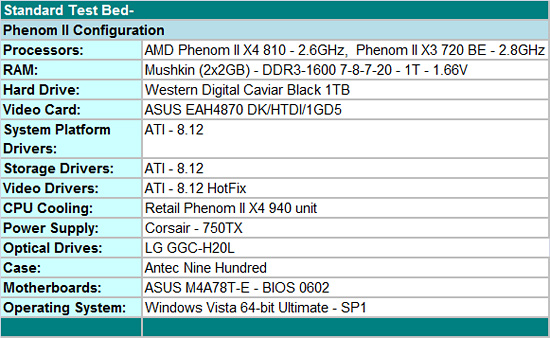
We selected the ASUS EAH4870 DK/HTDI/1GD5 video card for GPU duties. It is a non-reference design that offers improved thermals and acoustics over the standard HD4870 1GB cards in our board choices. The WD Caviar Black 1TB is the hard drive of choice for storage purposes. LG’s GGC-H20L Blu-ray drive fills in for optical duties. Our power supply is Corsair’s 750TX that we used in a couple of recent P45 and Phenom II CrossFire articles. The reason for this is to ensure similar power consumption numbers in our motherboard articles this year. However, in the IG centric motherboard tests we will show additional results with the Thermaltake TR2-430W power supply.
We selected Mushkin’s impressive DDR3-1600 kit to ensure our systems would not be limited by memory speed. We used 4GB in our standard benchmarks with memory set at DDR3-1600 with 7-8-7-18 timings at 1.66V. We will also test with some budget friendly DDR3-1333 from Patriot in the individual motherboard reviews. Our cooling choice is the retail unit from a Phenom II X4 940 as our engineering samples were not shipped with a heatsink/fan. Our clock speeds did not change with improved CPU air-cooling in today's test. However, temps did drop anywhere from 6C~9C at load with the Vigor Monsoon III LT we tested and would highly recommend utilizing an upgraded air cooler for the long term. We utilized Antec’s Nine Hundred case, yes, it is overkill for our uATX boards but we wanted to provide excellent cooling for our setups during overclocking for these particular tests.
Phenom II X3 720 BE Maximum Overclock on Stock Voltages
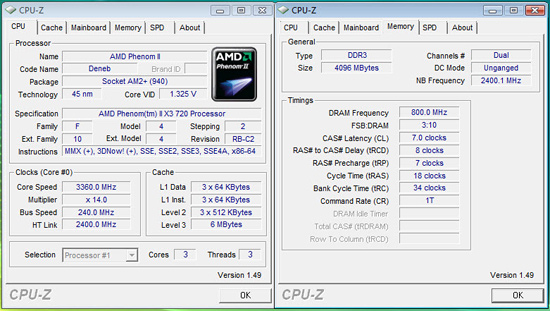
Our maximum overclock on stock Core VID with the X3 720 BE resulted in a 3.36GHz clock speed at a respectable 240HTT clock and Northbridge speed at 2400MHz. Memory speed is set to DDR3-1600 at 7-8-7-18 1T on 1.68V, slightly higher than our stock 1.66V for additional stability in Crysis Warhead. The primary voltages settings were left at auto in the BIOS with it determining a 1.3375V CPU/NB voltage. We tried a variety of CPU multipliers and HTT clock speed and still ended up around 3.3GHz as our maximum clock at the stock Core VID of 1.325V.
Phenom II X3 720 BE Maximum CPU/HTT Overclock
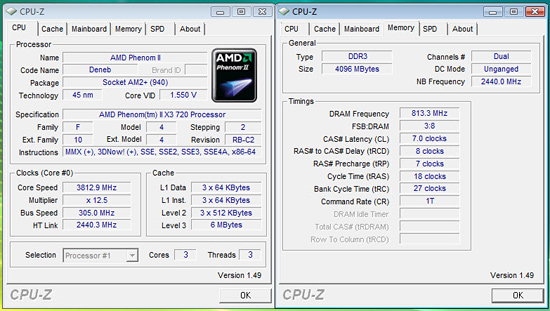
Our maximum overclock for both CPU and HTT speed ended up at a 12.5x305HTT setting. This resulted in a 3.812GHz processor clock speed with Northbridge speed at 2440MHz. We initially set our Northbridge speed to 2745MHz but could not hold stability in several of our benchmarks, regardless of voltage settings. We set Core VID to 1.55V, VDimm to 1.68V, CPU/NB Voltage to 1.4375V, and HT to 1.38V. Memory speed is set to DDR3-1627 at 7-8-7-18 1T. Our best performing and highest CPU/HTT setting was at 13x300 for a 3.90GHz core speed, but we could not hold stability in Crysis Warhead, Cyberlink Power Director 7, or the Movie/TV test in PCMark Vantage x64.
Phenom II X3 720 BE Maximum CPU Overclock
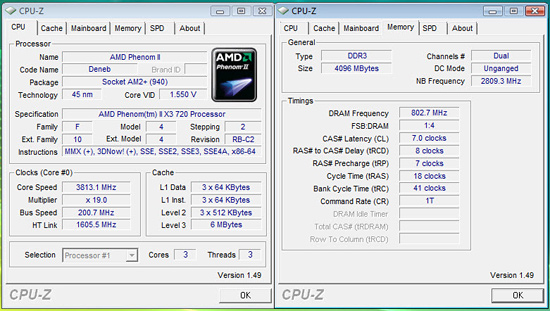
No surprises here based on our results above. Our maximum overclock for both CPU speed ended up at a 19x200HTT setting. This resulted in a 3.813GHz processor clock speed with Northbridge speed at 2809MHz. We set our Core VID to 1.55V, VDimm to 1.66V, CPU/NB Voltage to 1.4375V, and HT to 1.38V. on stock VCore with the X3 720 BE resulted in a 3.36GHz clock speed at a respectable 240HTT clock and Northbridge speed at 2400MHz. Memory speed is set to DDR3-1600 at 7-8-7-18 1T. We also tried the 19.5x200HTT setting for 3.90GHz, but could not hold stability in the applications mentioned above. The system would post at 20x200 easily, but Vista 64 SP1 would always BSOD once entering the OS. It appears from all indications that the AM3 processors have the same 4GHz limitation in Vista 64 with normal cooling methods. We increased VCore to 1.60V and could POST at 4.2GHz but could never enter the OS regardless of other NB speed, HT speed, or voltage settings.
Phenom II X4 810 Maximum Overclock on Stock Voltages
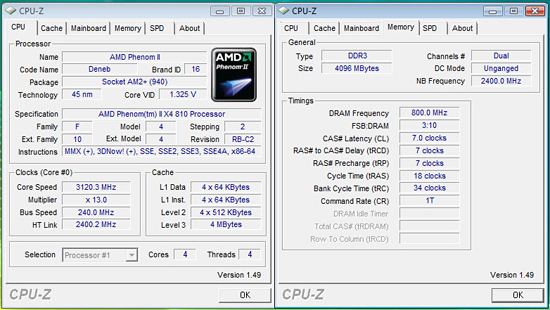
Our top overclock on stock VCore with the X4 810 resulted in a 3.12GHz clock speed at a healthy 240HTT clock and Northbridge speed at 2400MHz. Memory speed is set to DDR3-1600 at 7-7-7-18 1T on 1.66V. We left the primary voltages settings at auto in the BIOS with it determining a rather high 1.3750V CPU/NB voltage. We found through trial and error that a CPU/NB voltage of 1.3325 was stable at this clock speed. Since this CPU is locked, we could not increase the CPU multiplier but did try a variety of lower multipliers and higher HTT clock settings. However, on a stock Core VID and without greatly reducing memory speeds, our final 240HTT clock setting was the best we could accomplish.
Phenom II X4 810 Maximum CPU Overclock
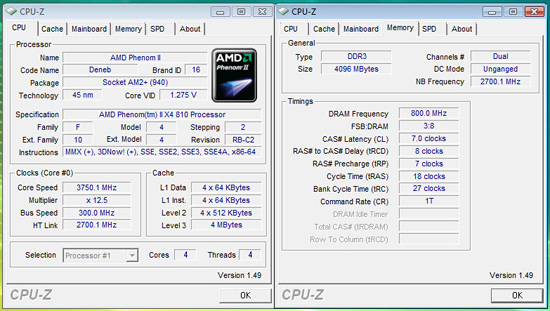
Our maximum overclock on the X4 810 ended with an offbeat 12.5x300HTT setting. This resulted in a 3.75GHz processor clock speed with Northbridge speed at 2700MHz. We tested a variety of combinations and this one resulted in our best CPU speed and overall system performance. We just could not go higher regardless of voltages or HT/Northbridge settings and keep the system stable. We almost had 13x295HTT stable at 3.83GHz but it would consistently fail most of our encoding benchmarks. We set Core VID to 1.55V, VDimm to 1.66V, CPU/NB Voltage to 1.4250V, and HT to 1.38V. One strange item we noticed is that our various reporting tools except TurboV from ASUS would show Core VID fluctuating wildly from 1.455V to 1.62V depending on the application. We checked with our DMM and voltage was at 1.571V on our 1.55V setting. Memory speed is set to DDR3-1600 at 7-8-7-18 1T. We also tossed in our new Corsair Dominator GT DDR3-2000 C7 kit for fun and had an easy time running 5-6-5-18 1T timings at DDR3-1600 with 1.62V on this board.
Final Words
When AMD launched the Phenom II X4 940 and 920 I called it a True Return to Competition. With the rest of the lineup now more fleshed out, it's truly a return to competition. At every price point that AMD targets, it has produced a CPU competitive to Intel's offerings.
These new CPUs from AMD are good overclockers, good performers and they don't have any real drawbacks unlike their predecessors. The most interesting CPU is the Phenom II X3 720; at $145 its only Intel competitors are the Core 2 Duo E7500 and the Core 2 Duo E8400, both of which are dual-core CPUs. The extra core in the 720 can provide a clear advantage in well threaded workloads, not to mention that it's got 1.5MB of L2 cache and 6MB of L3 cache at its disposal. In applications where the third core isn't very useful then the 720 loses its performance advantage, which I suspect will be the majority of mainstream workloads.
The DDR3 question is easily answered: wait. While DDR2 isn't an option for Core i7, on all other platforms it just makes sense simply because of the high cost of DDR3 right now. By the end of the year we won't be having this debate as DDR2/DDR3 will be at the same price, but if you're building today don't even bother looking at DDR3 unless you're building Core i7. The performance benefits aren't worth it for Phenom II, so while AM3 sounds cool, it's not necessary today. Thankfully AM3 CPUs will work in AM2+ motherboards, so you aren't forced into a relationship with DDR3 if you're not ready.
On the CPU side, what we end up with is a buyer's market with tons of choices. At the high end, if you can manage, the Core i7 is simply in a league of its own. Honestly, if I were spending close to $300 on a CPU today I'd do my best to make up for the differences in platform costs and go with an i7 over any Core 2 or Phenom II alternative.
At the low $200 price point you have the Phenom II X4 940 vs. the Core 2 Quad Q9400 once again. The 940 wins in the vast majority of cases and gets the nod at $225. The Phenom II X4 920 isn't as clear cut of a winner, as it competes with the Q8300 or the Q9400 depending on whether you want to spend slightly less or slightly more. Against the Q9400 it loses, against the Q8300 it should be a closer call. At $195 I'd call the decision torn, but I'd lean towards Intel. The same is true about the Phenom II X4 810, it actually does a lot better than I expected it would given the reduction in cache size and at $175 it is competitive with the Q8200. The strongest showing in today's introduction seems to be the Phenom II X3 720. If you do any amount of offline 3D rendering work or use any other heavily threaded apps, you'll appreciate the third core, although in most other applications the E7500/E8400 are competitive despite only being dual-core parts.
Long term this strategy can't work for AMD. Intel can make 3 E7500s in the space that AMD makes a single Phenom II X3 720; the pricing pressure is great for the consumer, but again, I'm not sure how great it is for AMD in the long run.
Other than the clear cut i7 recommendation at the high end, thanks to aggressive price cuts and competitive CPUs, you can actually have your pick of which side you want to go with here. I'd say what it really boils down to is who can deliver the best retail pricing on CPUs and motherboards. Overclockers will probably prefer the Intel route as both Phenom II and Core 2 can overclock to similar levels, but Core 2 is faster at the same clock speed. Intel does have more room to drive prices down if it should so desire and perhaps it will, although I do worry about what will happen to AMD's Phenom II strategy when Core i5 arrives later this year. While Phenom II is competitive with Core 2, remember that it's an old architecture now. Turn to the Core i7 results for where AMD will need to start looking come this fall...






























